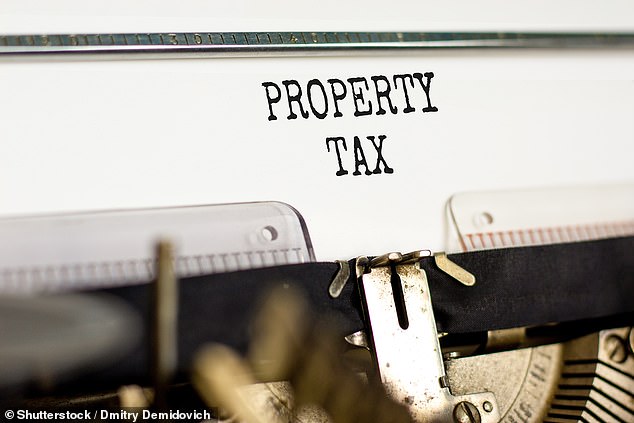Around 74,000 home buyers across England are predicted to narrowly miss the stamp duty deadline next month, according to analysis by Rightmove.
The property portal says more than 25,000 first-time buyers and nearly 49,000 home movers in England will fail to complete before 1 April, despite currently going through the legal process.
From 1 April, homebuyers will start paying stamp duty if the property they’re buying costs more than £125,000, the level it was at before temporary changes were made in 2022, which raised the threshold to £250,000.
The maximum extra charge for home movers that miss the deadline is £2,500.
First-time buyers currently pay stamp duty if their home costs more than £425,000, which will drop to £300,000 from 1 April.
This means instead of paying no stamp duty on a purchase worth £425,000, from April they will soon pay £6,205.

Final rush: Stamp duty is changing on 1 April, and this could cost a first-time buyer up to £11,250 in additional stamp duty while a home mover could end up paying £2,500 more
A first-time buyer buying a home worth £625,000 currently pays £10,000 in stamp duty. But from 1 April, that will rise to £21,250 – an increase of £11,250.
Coupled with higher mortgage rates this will add an extra financial burden for first-time buyers.
The net effect for this group, who are set to complete just one month later, is a collective £142million in additional stamp duty tax, compared with what they would have paid if they’d been able to complete in March, according to Rightmove analysis.
Today’s first-time buyers and home movers are already looking at substantially higher costs than they were when the exemptions were first introduced due to higher interest rates.
Rightmove looked at the total number of homes currently going through the legal completion process, and the date they are likely to complete, based on factors including the area and type of property.
The data is based on homes marked Sold Subject to Contract (SSTC) and Rightmove data on the average time to complete a home purchase, which is currently 163 days, or just over five months.
At a regional level, buyers in the South East are set to be most impacted, with the highest number of movers from the region set to only just miss out on the stamp duty deadline, and complete later in April.
With the South East being the second highest-priced region for homes, this group is also likely to face greater costs.
Should the government extend the deadline?
With home-movers understandably eager to avoid unnecessary extra costs, Rightmove is predicting a conveyancing log-jam as 31 March fast approaches, and those going through the completion process try to get their purchase over the line.
Rightmove is calling for a short extension to the stamp duty deadline by the government, to help the 74,000 home-movers who will only just miss out on the deadline and end up paying more tax through no fault of their own.
Particularly the 25,000 first-time buyers who will already be saving and stretching themselves as far as they can to get onto the property ladder.
Colleen Babcock, a property market expert at Rightmove said: ‘We expect a rush to complete close to March 31 as first-time buyers and home-movers try to avoid paying extra in tax.
‘Our numbers show how there is a relatively small, but disproportionately impacted group of first-time buyers who will be caught out by the changing thresholds, highlighting some disparities in the way the current system works.
‘With 74,000 people only just set to miss the deadline, in part because of the extremely lengthy completion times in England, we think it would make sense to grant a short extension to the deadline and help these movers, rather than have them face higher charges when they complete later in April.’
| Property price | Current stamp duty charge | Stamp duty from 1 Apr 25 | Additional charges £ | Current stamp duty charge | Stamp duty from 1 Apr 25 | Additional charges £ |
|---|---|---|---|---|---|---|
| Non-first-time buyer | First-time buyer | |||||
| £125,000 | £0 | £0 | £0 | £0 | £0 | £0 |
| £250,000 | £0 | £2,500 | £2,500 | £0 | £0 | £0 |
| £425,000 | £8,750 | £11,250 | £2,500 | £0 | £6,250 | £6,250 |
| £500,000 | £12,500 | £15,000 | £2,500 | £3,750 | £10,000 | £6,250 |
| £625,000 | £18,750 | £21,250 | £2,500 | £10,000 | £21,250 | £11,250 |
| £750,000 | £25,000 | £27,500 | £2,500 | £25,000 | £27,500 | £2,500 |
| £925,000 | £33,750 | £36,250 | £2,500 | £33,750 | £36,250 | £2,500 |
| £1,000,000 | £41,250 | £43,750 | £2,500 | £41,250 | £43,750 | £2,500 |
Some links in this article may be affiliate links. If you click on them we may earn a small commission. That helps us fund This Is Money, and keep it free to use. We do not write articles to promote products. We do not allow any commercial relationship to affect our editorial independence.










